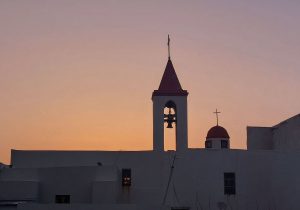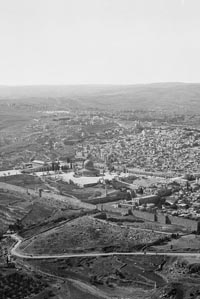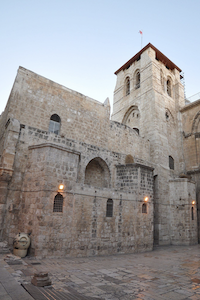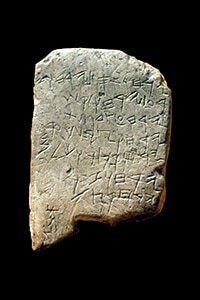
Not a Friend of ASOR yet? Sign up here to receive ANE Today in your inbox weekly!
June 2023
Vol. 11, No. 6
Who Knew? Uncovering Unexpected Histories in the Southern Levant
By Martine van den Berg
This past February, the first-ever Friends of ASOR Tour to Israel and the Palestinian Territories headed off for a 13-day archaeology trip. Norma Franklin of the University of Haifa was our ever-energetic tour coordinator and guide. Although I studied archaeology and lived in Israel for many years, my assumption that I knew my stuff turned out to be dead wrong. As we visited sites not yet open to the public and listened to the excavators sharing their recent discoveries, I was surprised to discover how recent explorations have yielded many paradigm-shifting insights into the layered history of the region. Here are a few of our experiences.

Yuval Gadot (left) and Filip Vukosavovic (right) at the Kidron Valley lookout point. (Photo by M. van den Berg)
Jerusalem
At 8.00 AM sharp we leave St. Andrews Guest House, a beautiful hotel with a breathtaking view over the walls of Jerusalem’s Old City. The tour starts at the highest point of the City of David, which is considered to be the place where the Biblical city developed. But did it?
Hunched over, we follow Yuval Gadot, Professor of Archeology at Tel Aviv University, through the dimly lit rock-cut tunnels towards the Gihon Spring. Along the way, Yuval shows us several archaeological remains that add to the enigma. This includes a wall he and Filip Vukosavovic recently uncovered, dating from the 8th century BCE. I immediately assume it be a project of King Hezekiah, to whom the Bible attributes great architectural works, but no—the wall was built earlier, probably during the reign of the much less famous King Uzziah, who ruled in the first decades of the 8th century.

A section of the “Pilgrim’s Road”, ca. 1st century CE, which ran from the Siloam Pool up to Herod’s temple. (Photo by M. van den Berg)
That is not all. When excavators follow the earlier “city wall” that the famous Kathleen Kenyon attributed to the Bronze Age, it holds a surprise: it is part of a construction of two parallel walls that run all the way down to the Gihon spring, guarding its access. When we finally make it to the water source, Yuval points to a nearby structure built of large stones that turns out to be a tower protecting the spring. “When do you think this was built?” he asks. Recalling Kenyon’s interpretation, I mumble that it must be from the Middle Bronze. Again, no: C14 analysis under the floor level of the tower suggests it was built in the 9th century BCE. The impressive building activity around the spring—and not up the hill—has changed previous ideas of Jerusalem’s city development.
We walk through another, now dry, Middle Bronze Age tunnel, exiting into the bright Jerusalem sunshine. We head to one of the most important recent discoveries in the City of David: Pilgrims’ Road. It ran from the Siloam Pool all the way up to Herod’s temple. Consisting of flights of stairs, the path is eight meters wide and was once lined with shops. During the holidays, hundreds of thousands of Jewish pilgrims must have walked this street. We are here alone, as this part is not yet open to the public.
“The stones look brand new,” someone comments. This turns out to be quite accurate. The road was probably built during the rule of the Roman procurator Pontius Pilatus between the years 30-40 CE. Consequently, it was only used for a few dozen years before the temple was destroyed and the street covered with dirt.
Although the Pilgrims’ Road leads all the way to the Temple Mount, we exit next to the Givati Parking Lot excavations, located on the northwestern side of the City of David. Dr. Yiftah Shalev of the Israel Antiquities Authority (IAA) sums up how the excavations have uncovered a cross-section of Jerusalem’s rich history: from an Ottoman trash pile all the way down to the Middle Bronze and everything in between. Yuval shows us one of the most impressive discoveries: an Iron Age building, constructed in the 8th century BCE and in use until the destruction of the city by the Babylonians in 586 BCE. In its final phase the building had a wine cellar. Thanks to residue analysis of the contents of the storage jars, we know that the people who lived here liked their wine with a hint of vanilla flavor!
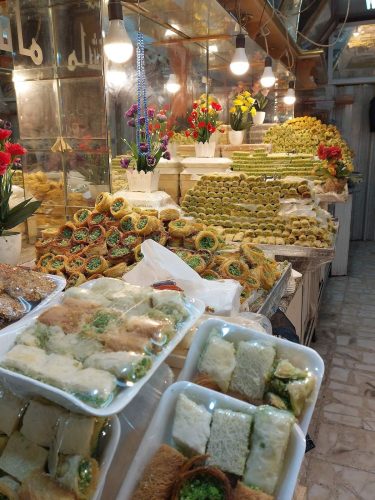
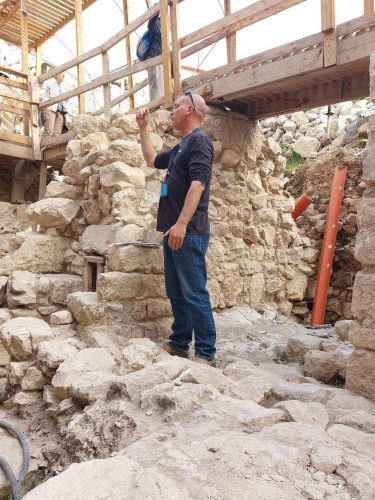
Jerusalem has more to give. The following days we enjoy an extensive tour of the Western Wall excavations and follow clues from 19th century pictures, paintings, and models to understand where the Second Temple was located. After enjoying tasty lunch at the Austrian Hospice, we push through the crowds in the souk towards the Christian Quarter for a visit to the Church of the Holy Sepulchre, where, according to tradition, Jesus was buried after his crucifixion. It is Ash Wednesday and masses of pilgrims throng the streets.
When we near the church, our guide, Dr. David Gurevich of Haifa University, makes an unexpected turn and enters the small door of the Alexander Nevsky church, built in the 19th century. Once inside, to the right of the narrow hallway appears a large gate and a perpendicular wall. Although everyone by now can recognize the Herodian masonry, this is not a Herodian wall, but a later reuse of these stones
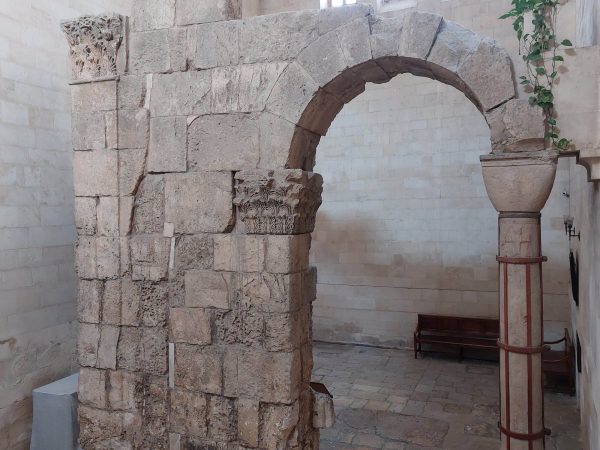
“But are we really looking at a city wall?” David asks rhetorically. He points to the holes in the structure, which suggest it was once covered with marble slabs. David’s theory is that it is either the corner of the temple of Venus that was built by emperor Hadrian in the 2nd century CE, or part of the first church, built by Constantine in the 4th century, or both: Constantine perhaps (re-)used the temple to Venus, incorporating it in his church. But today this wall is outside of the Holy Sepulchre. David produces a map that shows how in its earliest phases the church was much bigger and reached all the way to where we stand.
When we eventually visit the Holy Sepulchre itself, we make our way through crowds to get a look at the rock-cut graves from the Second Temple period that lie off the Rotunda. Today Jerusalem again proves to be a city of many layers, not only of archaeology but also of living traditions.
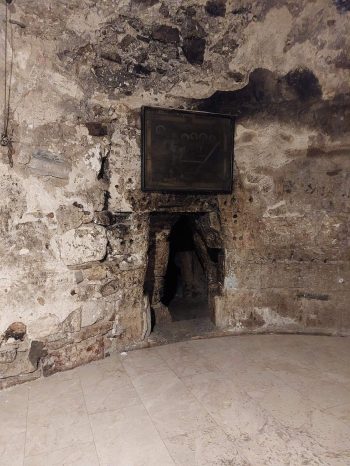
Off the Beaten Track: Samaria
Although I lived in Israel for many years, I had never visited Mount Gerizim or Samaria/Sebaste before. The archaeological sites are off the beaten track for tourists and locals alike. It is a beautiful Sunday morning when we drive through the green hills. Just before reaching Nablus, we turn left and the bus climbs up to Mount Gerizim, the holy place of the Samaritans. The wind is still cold, but the view is breathtaking. It is not difficult to imagine why the people on this mountaintop felt close to the divine. Up till this very day, the Samaritans come here to pray and sacrifice. There is a certain magic to this place; although lacking the multiple layers of Jerusalem, it feels somehow more ancient and authentic.
As usual, there is more than meets the eye. Excavations have uncovered some Persian remains, a large Hellenistic city, and the clear outline of an orthogonal Byzantine church. Our guide, Dr. Aharon Tavger, explains that the current consensus is that the earliest cultic activity dates from the Persian period. This is corroborated by ancient sources and archaeological remains alike. But recent excavations have uncovered a new twist in this story: between the spring grass and yellow flowers, we recognize the outline of a typical six-chambered gate familiar in the Iron Age. This might indicate that this structure led to a cultic area from the same period. Hopefully, the forthcoming publication of the excavations will shed additional light on this interesting find, which might prove that the Samaritan tradition about the place is right after all.
At noon we arrive at Kiryat Luz, the Samaritan village. In the tiny Samaritan museum, we meet Priest Yefet Cohen, the brother of the current Samaritan High Priest. He captivates us with the history of his people and proudly shows us his genealogical tree and the Pentateuch in the Samaritan script. We are all impressed by his friendly and warm welcome.
Norma shows us around the ancient capital of the Israelite kingdom, Samaria. We drive up to the site along a colonnaded street up to the Roman Forum, now a parking lot. It was King Herod who renamed the former capital of the northern kingdom of Israel to Sebaste and crowned the summit with an impressive temple dedicated to Augustus. On the summit, the large forum and a theater attest to its importance as a Roman colony. Norma explains how the royal palace and summit were separated from the surrounding area by an artificially cut four-meter-high, rock-cut scarp. She also notes two caves cut into the scarp below the palace that are marked as cisterns, but in fact look more like two tombs. She recalls how the Bible says that the kings are buried “in their houses”. Is it possible that these “cisterns” are the tombs of king Omri or Ahab? I am fascinated by the thought.
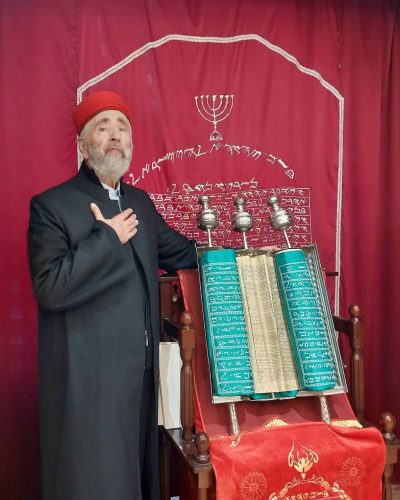
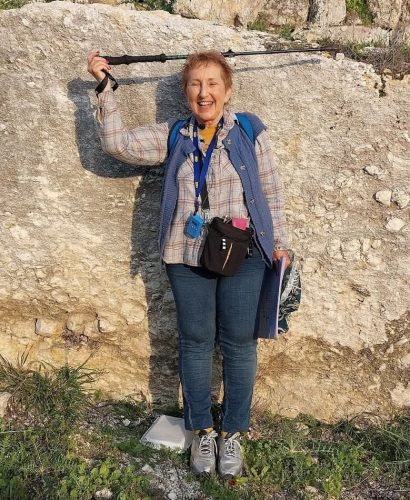
Behind Closed Doors: The Labs
The line-up of tells, museums, and digs during these thirteen days is incredible. Every place deserves its own story. We admire the diverse landscapes, whether it is the desert near the Herodium, the abundant spring flowers near Tel Bet Mirsim, or the green fields surrounding Tel Megiddo, Tel Jezreel, and Tel Hazor. We get a taste of the culinary richness of the area: from hummus and authentic Palestinian Maqluba (chicken-and-rice served “upside down”) to the Michelin-star-worthy fish restaurant of Uri Buri in Akko. I buy Uri Buri’s cookbook and try his recipes at home, but of course, it doesn’t taste half as good as in the Akko harbor just after a beautiful Mediterranean sunset.
A few more experiences are especially worth mentioning, as they bring us even closer to the multifaceted history of the Levant. We visited the Dead Sea Scrolls Unit of the IAA, located in the Israel Museum. To our delight, Dr. Joe Uziel, the head of the unit, shows us a large fragment of the DSS Q11 Psalms Scroll, which is so well preserved that the Hebrew readers among us can make out the line “Hine ma tov we ma naim” of Psalms 133. Another scroll fragment is immediately recognized by one of our distinguished tour participants, Bruce Zuckerman, who has worked on this fragment.
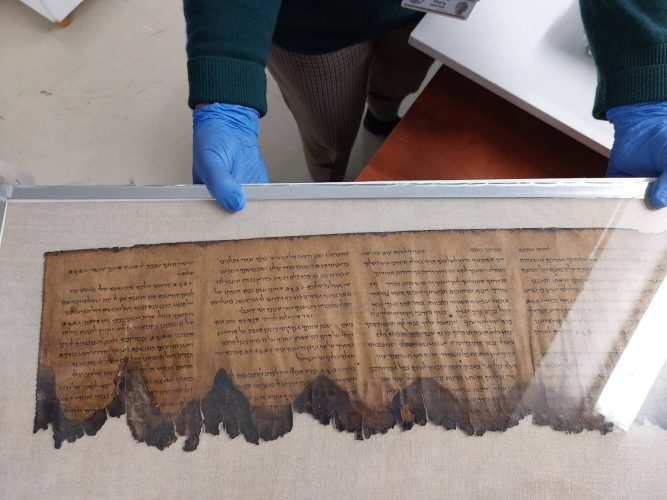
Another striking document is the deed to an orchard owned by a Jewish woman named Babatha, who in the 2nd century CE hid in the desert to escape the Romans during the Bar Kochba revolt. Her archive contains manuscripts written in Greek, Aramaic, and Nabataean and demonstrates not only her cosmopolitan outlook but also that women like her could enjoy a surprising level of economic independence.
The IAA’s Rare Coin department is no less interesting. Although the tiny room is hardly pretentious, the coins that curator Robert Kool shows are extremely rare. When Robert hands us a shiny golden coin of the 3rd century BCE naming Ptolemaic queen Arisnoë, ASOR President Sharon Herbert immediately recognizes it. It turns out her team found it during their excavation of Tel Qadesh a few years before. When we pass along the large and rather heavy coins of Alexander the Great, we are in awe. This is not something most of us experience daily.
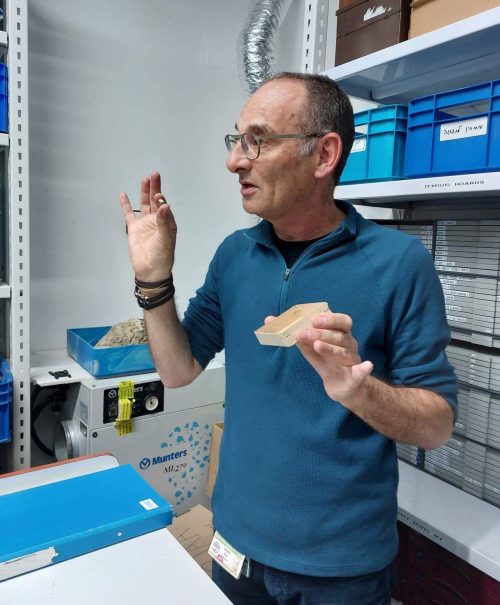
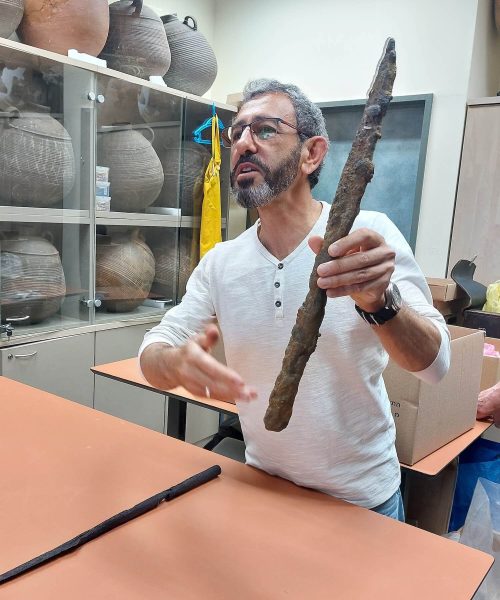
Near the end of our tour, we visit the Archaeology and Maritime Archaeology Laboratories of the University of Haifa. Here we get a close-up look at objects that are miraculously preserved from an early Islamic ship. These objects demonstrate that—contrary to earlier assumptions—trade in the area did not stop in the Islamic period. Another research group is working on the ceramics of the undisturbed Late Bronze Age burial cave at Palmachim, which was discovered by chance in 2022. Most of the pottery is intact and many of the vessels are beautifully decorated with Cypriote motifs. As we walk past the long table full of objects, we marvel at this unique window into lives lived more than 3000 years ago.
On our last night as a group, we compare and discuss our experiences. Everyone agrees that the trip far exceeded our expectations. Not less important, we had a wonderful group of participants. Everyone had something to contribute, and new friendships were struck. And if there is one thing that summarizes the trip it is this: don’t ever think that the history of Israel is fixed in stone.
Martine van den Berg has a BA in Religion from Utrecht University and an MA from the Hebrew University of Jerusalem, specializing in Public Buildings of the Second Temple Period. Currently she is working as an independent researcher and podcast-maker. In September her first non-fiction book will be published, which discusses how societies throughout history have dealt with crises and sudden disaster.
Want To Learn More?
David’s Jerusalem
By Daniel Pioske
In a letter sent to Charlemagne sometime just prior to 800 CE, Alcuin of York praised his “David,” as Charlemagne wished to be called later in life, for the benevolence with which he “ruled and governed” over Jerusalem. Read More
Absences, Archaeology, and the Early History of Monotheistic Religions in the Near East
By Robin Derricourt
Absence of evidence is a constant in archaeology. In writing the early history of monotheistic religions, what insights can we gain by focusing on these “absences”? Read More
From Texts to Scribes: Evidence for Writing in Ancient Israel
By Philip Zhakevich
What do we know about ancient Israel’s scribal culture? Can two words in the biblical text, the verb ‘write’ (katav) and the noun ‘scribe’ (sofer) help us understand the act of writing? Read More


